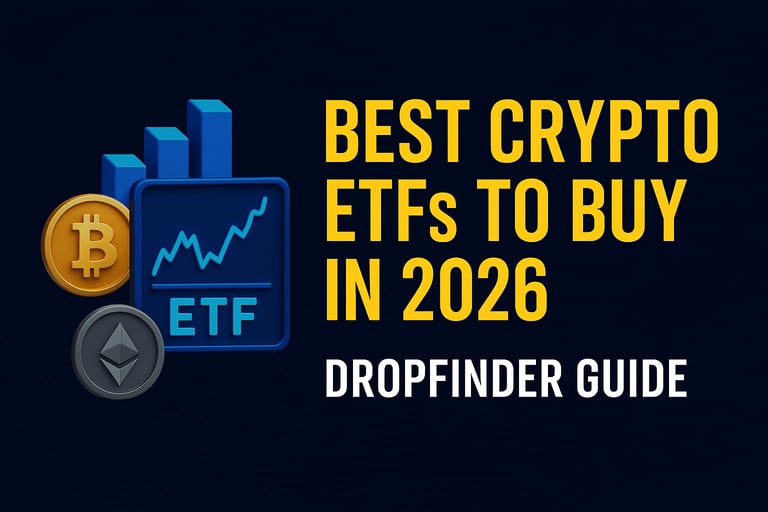Best Crypto ETFs to Buy in 2026: The Ultimate DropFinder Guide
Explore the best crypto ETFs to buy in 2026 with DropFinder’s in-depth guide. From Bitcoin and Ethereum ETFs to diversified crypto funds, discover which ETFs could outperform in the next bull cycle.
CRYPTO NEWS
11/11/20256 min read
Best Crypto ETFs to Buy in 2026: The Ultimate DropFinder Guide
The crypto world is entering its most mature phase yet. From a wild west of digital speculation to a regulated, institutionally backed ecosystem — the transformation is happening right before our eyes.
By 2026, crypto exchange-traded funds (ETFs) are expected to dominate mainstream investing, allowing millions of people to gain crypto exposure safely through regulated financial products.
So which crypto ETFs stand out as the best investments heading into 2026?
In this DropFinder report, we break down the top-performing Bitcoin, Ethereum, and multi-asset ETFs, analyze their institutional flows, and reveal which ones may lead the next bull cycle.
1. Why Crypto ETFs Matter in 2026
Crypto ETFs have unlocked the floodgates of institutional capital.
In previous cycles, investors had to manage private keys, wallets, and volatile exchanges. Now, with ETFs, investors can hold crypto exposure in traditional brokerage accounts — making it easier, safer, and tax-efficient.
For institutions, this marks a turning point. Pension funds, family offices, and corporations that couldn’t previously invest in crypto due to compliance constraints now have regulated pathways to allocate billions into Bitcoin and Ethereum.
By 2026, analysts project global crypto ETF assets could surpass $500 billion — a monumental leap from 2024’s early ETF launches.
DropFinder identifies three major ETF categories shaping this revolution:
Bitcoin Spot ETFs
Ethereum Spot ETFs
Diversified Crypto and Blockchain ETFs
Each plays a unique role in the evolving market landscape.
2. Bitcoin Spot ETFs: The King of the Next Cycle
When the U.S. approved spot Bitcoin ETFs in 2024, it triggered one of the biggest financial milestones in crypto history.
Leading asset managers like BlackRock, Fidelity, and ARK Invest quickly launched their own Bitcoin ETFs, fueling record-breaking inflows.
By 2025, the combined assets of these ETFs exceeded $100 billion, proving that traditional investors were eager to embrace Bitcoin through regulated products.
Top Bitcoin ETFs to Watch for 2026
iShares Bitcoin Trust (IBIT) – BlackRock
BlackRock’s IBIT became the market leader, thanks to its strong liquidity, low fees, and institutional credibility. With consistent daily inflows, IBIT is seen as the “S&P 500” of Bitcoin ETFs — reliable, scalable, and long-term focused.
Fidelity Wise Origin Bitcoin Fund (FBTC)
Fidelity’s Bitcoin ETF has grown rapidly due to its reputation among traditional investors. Known for deep research and active engagement with regulators, Fidelity’s approach focuses on building Bitcoin as a long-term treasury asset.
ARK 21Shares Bitcoin ETF (ARKB)
ARK Invest, led by Cathie Wood, targets growth investors who believe in exponential trends. ARKB often leads in innovation and is popular among retail traders who want exposure to Bitcoin’s upside through a trusted brand.
DropFinder Insight:
Bitcoin ETFs will likely remain the dominant crypto investment vehicle through 2026. DropFinder projects a 150% to 250% AUM growth in Bitcoin ETFs by mid-2026, potentially fueling the broader BTC price rally toward $200,000.
3. Ethereum Spot ETFs: The Rising Star of Smart Contracts
After the success of Bitcoin ETFs, the next major approval came in 2025 — Ethereum Spot ETFs.
Ethereum remains the heart of decentralized finance, NFTs, and smart contracts. As institutions began recognizing its utility and yield potential (via staking), Ethereum ETFs became the logical next step.
Top Ethereum ETFs for 2026
VanEck Ethereum ETF (ETHV)
VanEck’s ETHV was among the first approved Ethereum ETFs. It offers pure ETH exposure, allowing investors to participate in Ethereum’s growth without direct crypto custody.
Fidelity Ethereum ETF (FETH)
Fidelity leveraged its crypto research arm to design a low-fee, institution-friendly Ethereum ETF. It quickly became one of the most liquid ETH products in the market.
ARK 21Shares Ethereum ETF (ARKE)
ARK’s Ethereum fund focuses on long-term innovation trends — DeFi, gaming, and AI integration — making it ideal for investors looking to bet on Ethereum’s ecosystem dominance.
DropFinder Prediction:
As staking becomes more integrated into ETF structures, Ethereum ETFs could yield passive income on top of price appreciation. By 2026, Ethereum ETFs could hold more than 5 million ETH, representing a major shift in institutional demand.
4. Multi-Asset and Blockchain ETFs: The Diversified Approach
Beyond single-asset funds, a new wave of multi-crypto ETFs is gaining traction. These funds track baskets of major cryptocurrencies or blockchain companies, providing balanced exposure for risk-conscious investors.
Top Diversified Crypto ETFs for 2026
Bitwise Crypto Industry Innovators ETF (BITQ)
BITQ invests in both crypto assets and publicly traded blockchain firms such as Coinbase, MicroStrategy, and Marathon Digital. It offers diversified crypto exposure tied to industry fundamentals.
Global X Blockchain ETF (BKCH)
BKCH focuses on companies building blockchain infrastructure — miners, exchanges, and payment processors. This ETF performs well during high adoption cycles.
Grayscale Future of Finance ETF (GFOF)
Grayscale’s ETF takes a forward-looking approach, investing in firms shaping digital payments, tokenization, and decentralized finance ecosystems.
DropFinder Analysis:
Multi-asset ETFs are ideal for investors seeking exposure beyond Bitcoin and Ethereum without taking on direct crypto custody risk. They perform particularly well during mid-cycle consolidation phases when Bitcoin dominance starts to decline.
5. The Macro Case for Crypto ETFs in 2026
To understand why crypto ETFs are thriving, we must look at the macro landscape shaping global markets.
By 2026, inflation remains a concern across developed economies. Governments are struggling with mounting debt and fiat currency debasement. Central banks are expected to adopt looser monetary policies, injecting liquidity back into markets.
Historically, such conditions create bullish environments for hard assets — gold, Bitcoin, and Ethereum.
Crypto ETFs are perfectly positioned to capture this wave, acting as the bridge between traditional capital markets and decentralized digital assets.
DropFinder analysts expect a new cycle of capital rotation from bonds and real estate into digital stores of value. This shift could be the defining financial trend of the decade.
6. Institutional Adoption and the Regulatory Shift
In 2024, Bitcoin ETFs broke barriers. By 2025, Ethereum ETFs solidified credibility. In 2026, regulatory clarity is expected to expand toward multi-chain ETFs and DeFi index funds.
Governments and financial regulators, especially in the U.S., Europe, and Singapore, are adopting frameworks to classify digital assets as legitimate investment commodities.
Once this clarity stabilizes, major funds — including sovereign wealth funds and pension portfolios — can allocate a portion of their assets into crypto ETFs without legal complications.
DropFinder’s research forecasts that institutional allocations could reach 2–3% of global assets under management by 2026. Even this small shift represents trillions in potential inflows.
7. DropFinder’s ETF Performance Model for 2026
According to DropFinder’s predictive analytics model, which tracks AUM growth, on-chain data, and institutional buying, the following projections hold strong probability:
Bitcoin Spot ETFs: 3x growth from 2025 levels
Ethereum ETFs: 4x growth from initial inflows
Blockchain Equity ETFs: 1.8x growth
Multi-Asset Crypto ETFs: 2.5x growth
Under this model, total crypto ETF capitalization could surpass $750 billion globally by 2026, marking a 500% increase since the ETF era began in 2024.
8. Risks of Investing in Crypto ETFs
While crypto ETFs provide safer access, they still carry certain risks investors should understand.
Market Volatility: Crypto remains inherently volatile. ETF prices can swing dramatically based on Bitcoin and Ethereum’s spot performance.
Tracking Error: Some ETFs may not perfectly follow the spot market, especially if they use futures or synthetic exposure.
Regulatory Risk: Sudden legal restrictions or taxation changes could affect ETF operations or investor sentiment.
Liquidity Risk: Smaller ETFs might struggle with low trading volume, increasing spreads.
DropFinder emphasizes a diversified allocation strategy — balancing exposure between Bitcoin, Ethereum, and broader blockchain ETFs to mitigate these risks.
9. How to Choose the Best Crypto ETF for You
Before investing, DropFinder recommends considering these key factors:
Underlying Asset – Is it Bitcoin, Ethereum, or diversified exposure?
Fee Structure – Look for low management fees (0.2%–0.4% ideal).
Liquidity – Higher daily trading volumes ensure tighter spreads.
Custody Partner – Institutional-grade custodians like Coinbase Custody or Fidelity Digital Assets indicate security.
Issuer Reputation – BlackRock, Fidelity, and ARK remain the most trusted names in crypto ETFs.
By comparing these metrics, investors can select ETFs that align with their risk tolerance and market outlook.
10. DropFinder’s Top 5 Crypto ETFs to Buy for 2026
After analyzing institutional inflows, performance consistency, and long-term potential, DropFinder’s research team has identified the following as the Top 5 Crypto ETFs for 2026:
BlackRock iShares Bitcoin Trust (IBIT) – The institutional benchmark ETF for BTC.
Fidelity Wise Origin Bitcoin Fund (FBTC) – Best for long-term holdings with low fees.
VanEck Ethereum ETF (ETHV) – Ideal for ETH exposure post-ETF approval.
ARK 21Shares Ethereum ETF (ARKE) – High-growth ETH ecosystem investment.
Bitwise Crypto Innovators ETF (BITQ) – Balanced play between crypto and blockchain equities.
Each of these ETFs offers exposure to different sides of the digital economy — from Bitcoin’s store of value narrative to Ethereum’s decentralized infrastructure and blockchain equity growth.
11. The Future of Crypto ETFs: Tokenized Portfolios and AI Integration
By 2026, innovation in financial technology will push crypto ETFs even further.
Tokenized ETFs will allow investors to hold fractional shares directly on blockchain networks, enabling faster settlements and greater transparency.
AI-driven portfolio rebalancing will automatically optimize exposure based on market conditions, making ETFs smarter and more adaptive.
DropFinder predicts that tokenized ETFs could become the standard investment format by 2030, merging DeFi and TradFi into a single ecosystem.
12. DropFinder’s Long-Term Crypto ETF Outlook
From 2024 to 2026, crypto ETFs will transition from niche financial products to mainstream investment instruments.
Bitcoin ETFs will serve as digital gold.
Ethereum ETFs will act as digital infrastructure exposure.
Multi-asset ETFs will function as crypto index funds for diversified investors.
DropFinder forecasts that by the end of 2026, 10% of all crypto market capitalization could be held through ETFs, marking one of the most significant adoption milestones in financial history.
Conclusion
Crypto ETFs have redefined the way investors access digital assets. With Bitcoin and Ethereum ETFs already leading the charge and multi-chain funds gaining traction, the next 18 months could see unprecedented growth in ETF participation.
For investors seeking exposure to crypto without the complexities of self-custody or unregulated exchanges, ETFs represent the safest and smartest bridge into the blockchain economy.
DropFinder’s analysis shows that 2026 will be the golden age of crypto ETFs — where regulated products meet exponential innovation.
The key is to position yourself early, stay informed, and diversify wisely across the top-performing ETFs shaping this digital revolution.
Because in the next cycle, it won’t be just about owning crypto — it’ll be about owning the future of finance itself.




